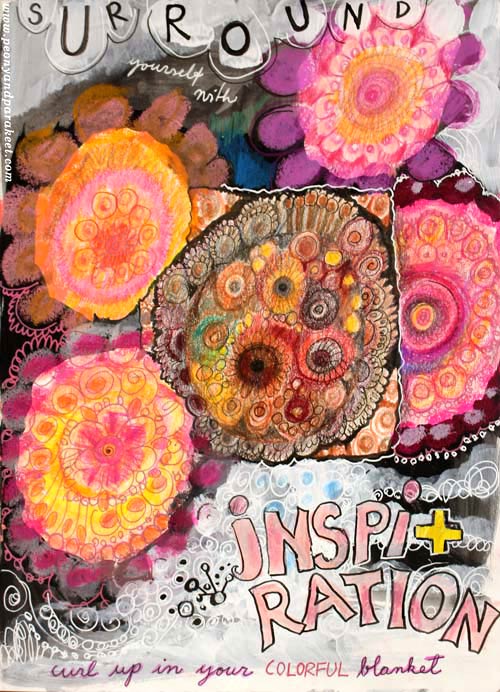Using Fabric on Art Journal Pages
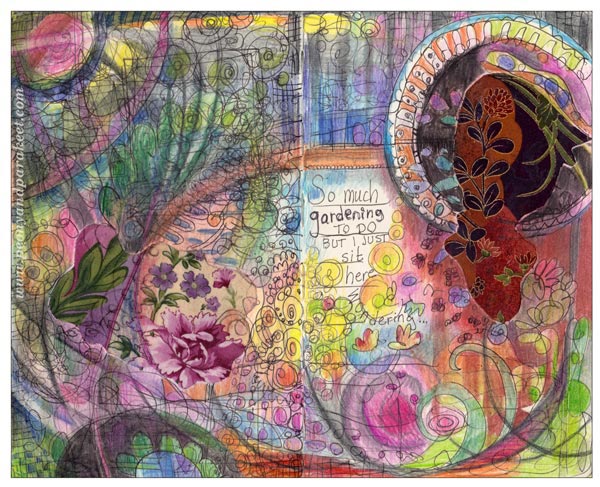
At this time of the year, at the beginning of summer, there’s a lot to do in the garden. I started early this year, but recently there has been so many activities that I feel I have neglected the garden. This guilty feeling also showed up on my latest art journal page!
This page is made on a spread of Moleskine Sketchbook, so the image is fairly small, about 10 inches in width. A special feature here is that I have added two small cotton fabric pieces to boost my imagination. Using the technique of fabric collage was just a sudden idea, but I love how the page feels when touched!
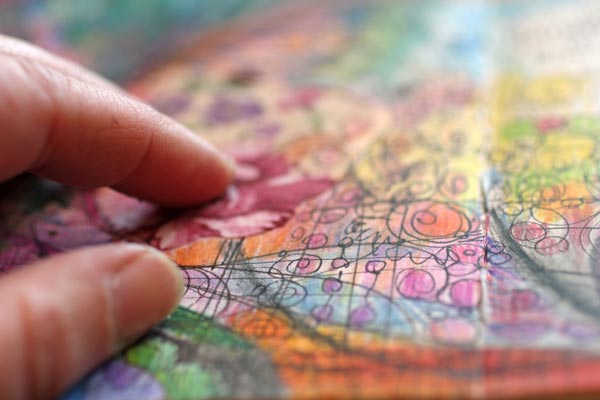
I attached the first fabric piece at the early stage. Golden Soft Gel Gloss Medium was used for attaching the fabric.
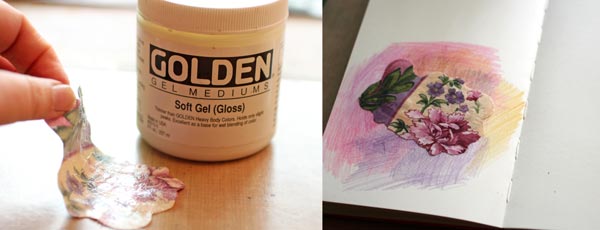
After attaching the fabric, I doodled with a black drawing pen to get the creativity going.
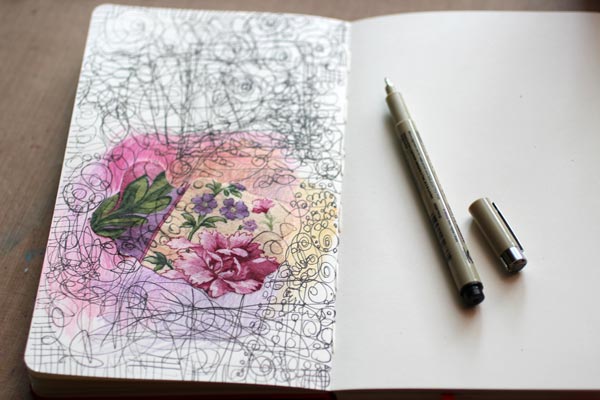
When I began coloring, I realized that I want to create a spread instead of a page. So I attached another fabric, purposefully a bit different from the first.
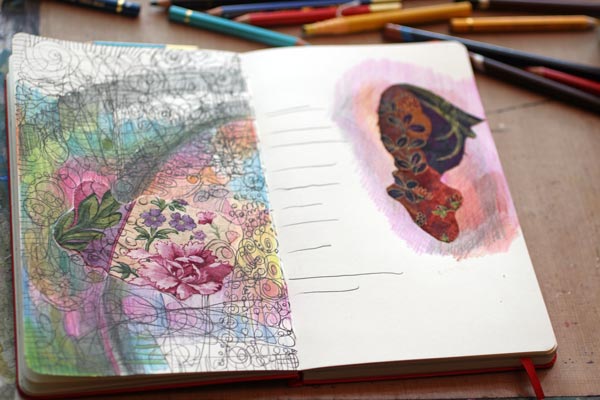
While coloring the page, I added more details. As my garden looks wild at the moment, I wanted to show the growth on the page too.
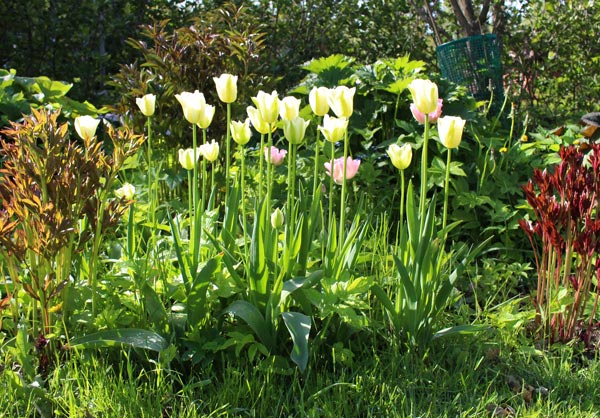
Here’s one corner of our front garden. Tulips bloom beautifully, and peonies (my favorites, of course!) grow fast. Lots of weeding to be done!
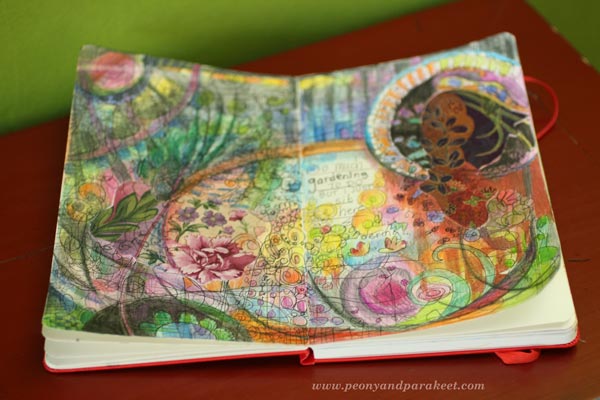
Why not try some fabric collage in your journal?
Let me be your art teacher: Subscribe to my weekly emails!
Intuitive Start for Art Journaling
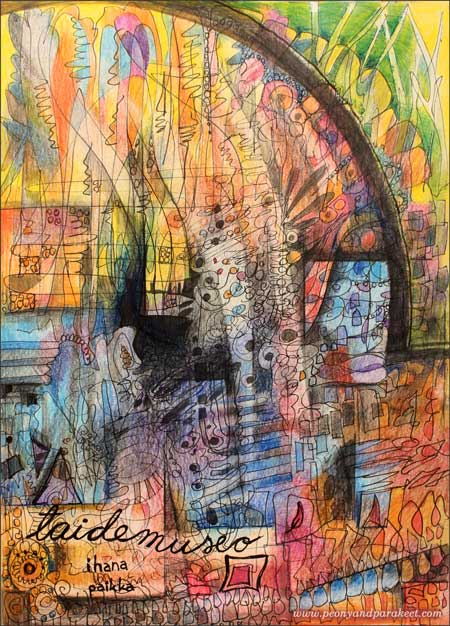
My latest art journal page is about one of my favorite places: art museums. On the page, I have used both organic and graphic shapes to express the interaction between art and architecture. That interaction is something I enjoy examining when handling art museum inspiration.
Inspiration
Last week I went to Kunsthalle Helsinki to see an exhibition of Erling Neby Collection. Erling Neby is a Norwegian businessman who collects concrete and geometric art.
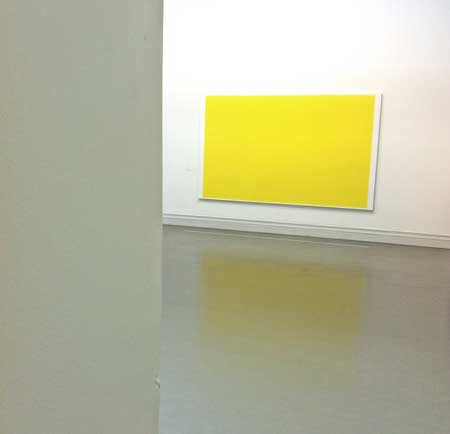
This kind of art makes me remember the time when I was in my 20s and very certain of what kind of art I like and what I don’t like. Simple-shaped abstract paintings were in my comfort zone back then – it was “good art” that I was excited to see and experience although I have never been able to stretch my personal style to that.
At the exhibition, the reflection of the yellow painting was especially inspiring. It made me think how art is never disconnected from its surroundings, whether physical or mental. Thus, an illustration about art museum would not need to separate artworks from the architecture but express the holistic feeling of the experience.
Techniques
I used a couple of black pens and colored pencils for creating the page.
1) Free doodling and coloring.
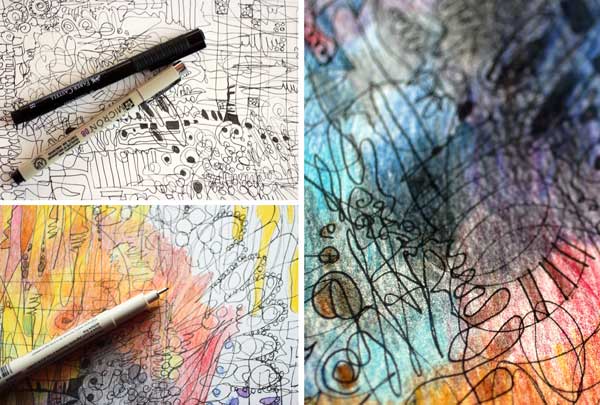
2) Drawing sharp graphic shapes with the help of a ruler and a round object. 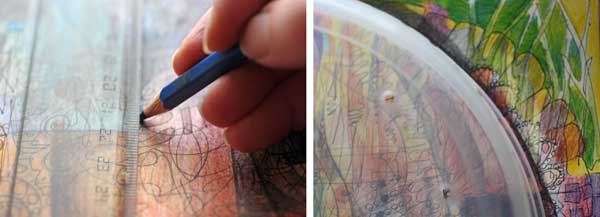
Emotional Connection
When I draw, I always want to get an emotional connection with the subject. Without that, I start to worry about the result before the first stroke! When making this page, I did not think about art museums in general. Instead, I thought about tiny details that I saw and tiny moments that I remembered from my last visit in Kunsthalle Helsinki. I focused on the feeling and let my imagination work with that.
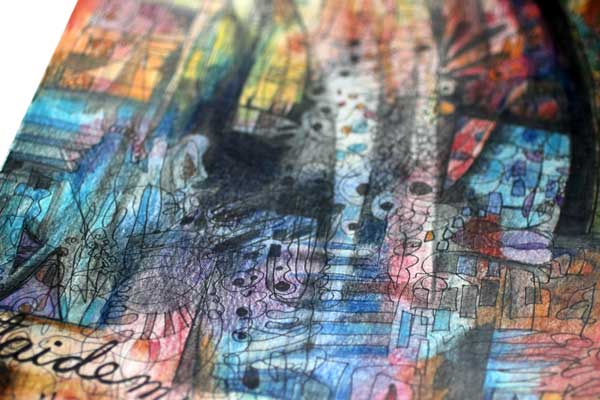
Inspirational Drawing
Working from tiny details towards the big picture is something that is not easy to explain in a single blog post. To explain it shortly, it is starting with an intuition and then slowly bringing the page towards the intention. This way of working is in the main role in Inspirational Drawing.
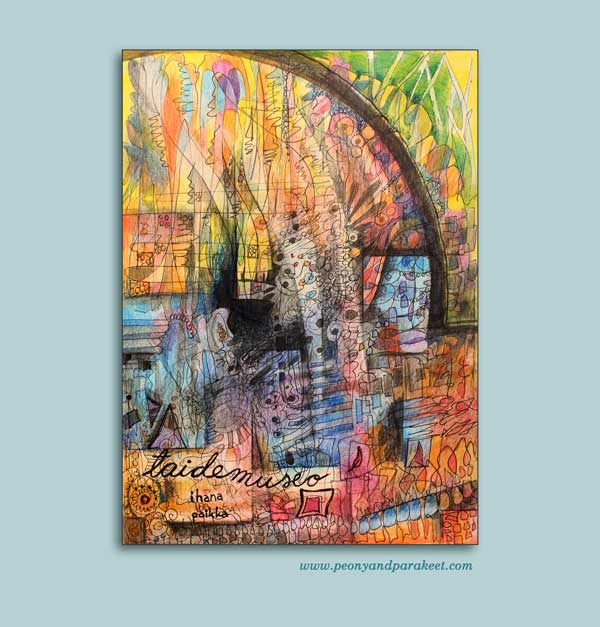
Inspirational Drawing is built so that you can enjoy developing the three dimensions of drawing:
1) increasing your imagination
2) improving your technical skills
3) using inspirational source material.
You will learn a creative process in detail through art journaling exercises. Course videos will not only show you how to do, but I also talk about the emotions and the inspiration behind them. I will answer your questions and help you adjust the process so that it will work for you. You can start enjoying free drawing without questioning what to draw or how the process itself will take care of that!
Why History, Computers and Art Belong Together
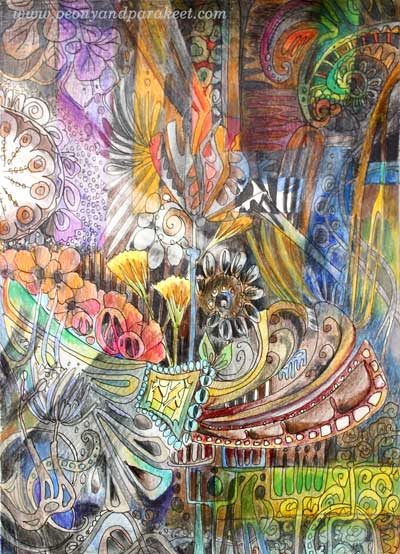
This art journal page is about two things that are close to me: art nouveau and computer engineering. With my background in technology, many find it surprising that historical styles like Art Nouveau fascinate me so much. And vice versa: why someone so interested in history, has studied and worked with computers.
Inspiring Periods of World History
For me, history, computers, and art have a natural connection. Think about the era of Art Nouveau: the end of 19th century and the beginning of 20th century. It was the era of the industrial revolution when many technical inventions were born. Also, at the same time, new kind of art was emerging. For example, Virginia Woolf wrote books using the stream of consciousness, Vincent van Gogh painted Starry Night, and Charles Rennie Macintosh designed a grand building for Glasgow School of Art. After inventing computers, we are experiencing another great era with a lot of innovations, the internet, and smartphones among others. I am certain that it will be seen as one of the most exciting time in the world history. We have new tools for art and design and we if any can use art to look at what the future could hold.
The Stream of Consciousness – Creating a Coloring Page
When I started to create the art journal page, I thought about the two eras and their similarities. With a black drawing pen, I began drawing art nouveau style shapes. It was exciting to think about modern things while drawing in the old style. It is very inspirational to stay focused on two things that have both similarities and differences.

It is relaxing to draw like imitating Virginia Woolf: using the stream of consciousness. Rotating the page makes it easier to keep the stream flowing.
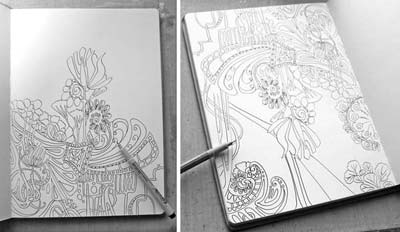
Coloring books seem to be popular at the moment. We art journalers can make our own! Here’s my page before coloring.
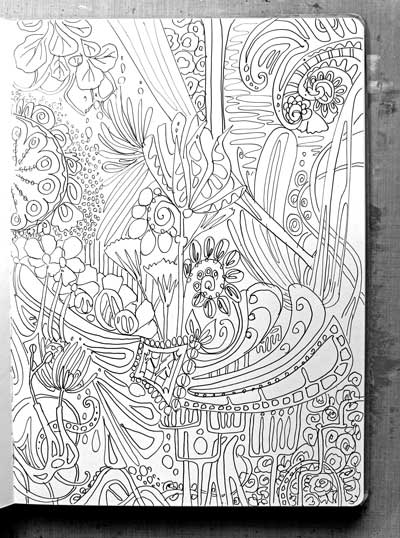
Past, Present, Future – Art Is an Equation
When I studied computer engineering, I had to understand a mathematical equation that was used widely to control technical systems. It was called Kalman filter and it was composed of three parts: past, present and future. I found the philosophy behind the equation most fascinating: to get better at what we do, we must understand the past, stay grounded to the present and be brave enough to predict the future.
Art can be our equation. We can use art to ponder on what has happened to us. We can use art to record the present. But most importantly: art can make us get off the ground. We can predict what the future will hold by taking old and current stuff and create new combinations. We can imagine what Virginia Woolf would do in the 22nd century and illustrate it. There are no limits and we already have most of the information.
That’s why I think that history, computers and art belong together. They are all parts of the same equation.
Adding New Dimensions by Coloring
To bring today’s graphic shapes to the work, I drew rectangular areas on the top of the drawing. Then I colored them with a different color scheme.

Finally, I expressed how past can bring us the future by erasing color with a light strokes. The light comes from the past. With the past, we can see the future.
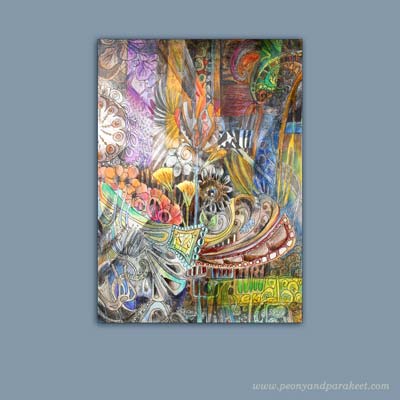
Tell me, what have you picked (or would like to pick) from the past to your art?
Create your own colored version of this page!
>> Buy Coloring Freely!
From Movie Posters to Art Journal Pages
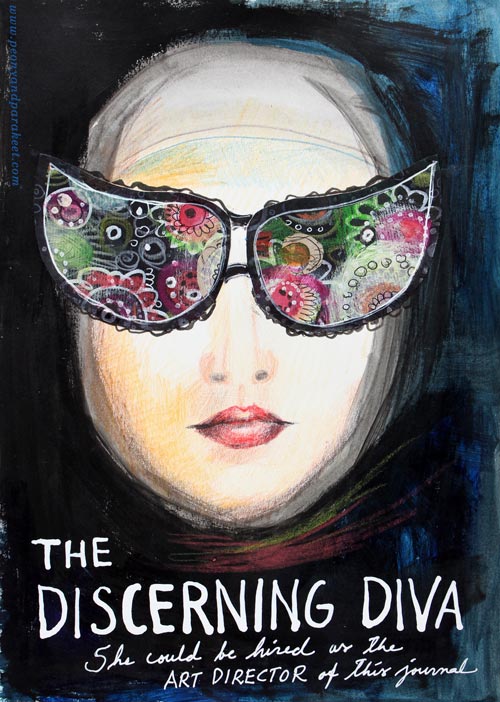
“The Discerning Diva – She could be hired as the art director of this journal.”
This page is my version of the poster for the movie “The Big Lebowski”. I have borrowed the concept of weird glasses and the composition from the poster, but it is still a separate artwork, not an exact copy.
The Discovery of Movie Posters
After learning that I like to use alphabet stamps in the art journal pages, I had been thinking about the next step in journaling. Last week I watched the poster artist James Victore‘s course Bold & Fearless Poster Design on Creative Live. His style has very little to do with mine, but I became fascinated by the visual concept of posters.
Last weekend I found a book about 1990’s movie posters at the local library. I became fascinated by the compositions used in the posters. Then it hit me: maybe I could replace the main elements with my own and apply the visual concept of the poster to my personal stories!
How to pick ideas from movie posters?
I will show you how to make your own “Discerning Diva” (very easy) but before that, I want to show you another poster-inspired page.

The page on the left is inspired by the poster for the movie “The Matrix”. I picked few main elements and the general atmosphere from the poster. The page on the right is made a long time ago, but I like how the two pages tell the story about being inside someone’s brain.
Four tips for picking ideas from the movie posters:
1) Composition: Examine the placement of the title, the grouping of the main elements and the most noticeable color contrasts.
2) Subject: Think about how your life could be applied to the movie.
3) Process: Examine the poster carefully but when you start creating, focus on your page and make it your own.
4) Imagine: Remember that you can replace the elements of the poster with whatever you like. For example, a person can be replaced with a vase of flowers.
Create Your Discerning Diva!
1) Paint the background of the page.
I used acrylic paints to make the background strong and heavy-looking. Leave an unpainted area for the face. Add water to the paint and gently brush the area around the face. Wet strokes create the impression of a thin scarf and add dimension.

2) Color the face.
I used colored pencils to maintain the big contrast between the background and the face. Add some color to the skin. Draw a mouth and a nose.

3) Add glasses.
Go to your box of hand drawn papers. Cut two lenses. Attach with glue or gel medium. Add frames with pens. Make the glasses as decorative as you like!

4) Add text.
Pick a color that has a high contrast with the background and journal on the bottom of the page. I have used a correction pen for the title and a white gel pen (Uni-Ball Signo) for the text below the title.

5) Add finishing strokes.
With colored pencils, add some strokes below the face to represent a scarf.
Add few strokes to outline the scarf near the forehead.
More Ideas for Compositions
Believe or not, this page is inspired by Austin Powers movie poster and hand embroidery! I think that hand embroidery has a lot in common with hand drawing.
Learn to draw from imagination and inspiration!
>> Buy Inspirational Drawing 2.0
